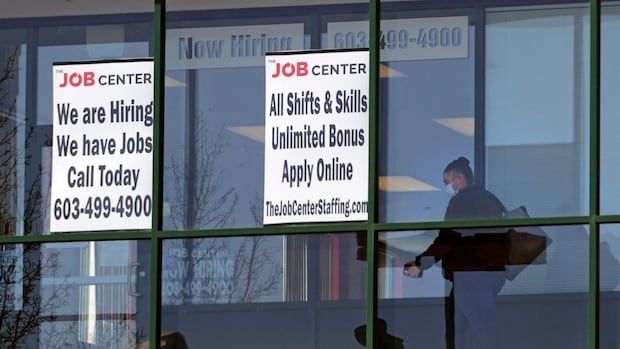U.S. job growth weakened sharply in August while the unemployment rate increased to nearly a four-year high of 4.3 per cent, confirming that labour market conditions were softening and sealing the case for an interest rate cut from the Federal Reserve this month.
The Labour Department’s closely watched employment report on Friday also showed that the economy lost jobs in June for the first time in four and a half years. Job growth has stalled, with economists blaming U.S. President Donald Trump’s sweeping import tariffs and an immigration crackdown that has reduced the labour pool.
Softness in the labour market is mostly coming from the hiring side. There were more unemployed people than vacancies in July for the first time since the COVID-19 pandemic.
Trump’s duties, which have boosted the nation’s average tariff rate to the highest level since 1934, stoked fears of higher inflation, prompting the U.S. central bank to pause its interest rate cutting cycle. Just as some of the uncertainty over trade policy was starting to lift with most tariffs now in place, a U.S. appeals court ruled last Friday that many of the duties were illegal, keeping businesses in a state of flux.
“The warning bell that rang in the labour market a month ago just got louder,” said Olu Sonola, head of U.S. economic research at Fitch Ratings. “The Fed is likely to prioritize labour market stability over its inflation mandate, even as inflation drifts further from the two per cent target. It’s hard to argue that tariff uncertainty isn’t a key driver of this weakness.”
The figures come as Canada’s own job figures pointed to trouble in the labour market. August saw the unemployment rate in Canada tick up to 7.1 per cent, and the economy bled 66,000 jobs.
Non-farm payrolls in the U.S. increased by only 22,000 jobs last month after rising by an upwardly revised 79,000 in July, the Labour Department’s Bureau of Labour Statistics said.
Economists polled by Reuters had forecast payrolls would rise by 75,000 positions after a previously reported gain of 73,000 in July. Estimates ranged from no jobs added to 144,000 positions created.
Revisions also showed payrolls declined by 13,000 jobs in June, the first drop since December 2020, rather than rising by 14,000, as had been reported last month.
The unemployment rate increased from 4.2 per cent in July, in part due to more people entering the labour force.
Some of the sharp job growth slowdown last month could be tied to a seasonal quirk. The initial August job count has tended to exhibit a weak bias, with revisions subsequently showing strength. Nonetheless, employment growth has softened considerably, averaging 29,000 jobs per month in the last three months, compared with 82,000 during the same period in 2024.
The bulk of the jobs added in August were in health care, with payrolls in the sector rising 31,000. But even this pillar of the labour market is showing strain as the increase was below the average monthly gain of 42,000 over the last 12 months.
Employment in the social assistance industry increased by 16,000 positions. Government data this week showed health care and social assistance job openings posting back-to-back declines in July.
Federal government payrolls dropped by 15,000, and employment in that area is now down 97,000 since January. A sharp decrease is expected in October after employees collecting severance pay fall off payrolls in the prior month.
There were job losses in a number of sectors, including wholesale trade, manufacturing, construction, and professional and business services.
“It’s a little bit of a disappointing job number, but I pretty much expect it’s going to revise up,” White House economic adviser Kevin Hassett told CNBC after the release of the employment report.
Fed chair Jerome Powell last month signalled a rate cut was possible at the U.S. central bank’s Sept. 16-17 policy meeting, acknowledging the rising labour market risks, but he also added that inflation remained a threat. The Fed has kept its benchmark overnight interest rate in the range of 4.25 per cent to 4.50 per cent since December.
U.S. Treasury yields fell on the data. The dollar declined against a basket of currencies.
U.S. President Donald Trump fired Erika McEntarfer, commissioner of the Bureau of Labor Statistics, after a report showed hiring slowed in July and was much weaker in May and June than previously reported.
Trump last month fired Erika McEntarfer, commissioner of the Bureau of Labour Statistics, accusing her, without evidence, of manipulating the employment data. That followed sharp downward revisions to payroll counts for May and June.
But economists have defended McEntarfer and attributed the revisions to the “birth-and-death” model, a method the Bureau of Labour Statistics uses to try to estimate how many jobs were gained or lost because of companies opening or closing in a given month.
“We are in a low-churn labour market, with not a lot of hiring or firing happening. So that means the job growth that we
do see in the economy is mainly driven by the net birth of new firms,” said Ernie Tedeschi, director of economics at the Budget Lab at Yale University.
“But that just happens to be the most imputed part. It’s the most sensitive to revision because it’s the result of explicit modelling by BLS, rather than something that they can survey.”
Trump has nominated E.J. Antoni, chief economist at the conservative think-tank Heritage Foundation, to replace McEntarfer. Antoni, who has penned opinion pieces critical of the bureau and even suggested suspending the monthly employment report, is largely viewed as unqualified by economists across political ideologies.

